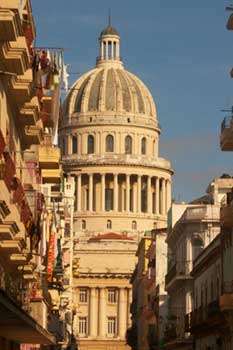The Giraldilla stands stylized; it has become with the passing of time in a symbol and legend of Havana. A city which its oldest part brags elegant streets of cobbles, and keeps buildings constructed centuries ago, museums with stories and traditions of a city which turned 493 years old last November 16.
There you can find buildings in which different architectural styles converge; streets where modern and ancient cars, baptized by Cubans as almendrones, run together. Today’s Havana, a city that proudly stands over the years and its usual deterioration.
The neighborhood of El Vedado, the Havana’s seafront, and the busy area of La Rampa with its granite sidewalks, and polychrome mosaics that adorn them, where are embedded, as a legacy to all Cubans, paintings of more than 20 famous Cuban plastic artists, including Cundo Bermudez, Amelia Peláez, René Portocarrero and Wifredo Lam.
The most populous municipalities of the city: October 10th, Central Habana and Old Havana with the Paseo del Prado and its lions roaring while the neighborhood kids’ ride them.
Several generations of Cubans live in Havana, where since the routine of every morning when children go to schools, while listening to the vendors announcing products. You can enjoy the bustle of the evening in a place where most of the time the sky shows the best of blue you can ever imagine, and you can also see, as by magic, nights transformed into new lives, according to the desire of its inhabitants, and the ones who visit the city.
The University of Havana is a special place, with its eternal youth, and atmosphere of wisdom, dreams, and history kept by the 88 steps of its staircase, where on top of the Hill, the Alma Mater statue opens its arms to welcome visitors.
Havana is also adorned by its corners, among the most famous are, Prado and Neptuno, the Coppelia ice cream parlor, 23 and 12, but the most prized of Havana is its simple and communicative inhabitants, whom discover every day a city that many people call, rightly, the capital of all Cubans.









